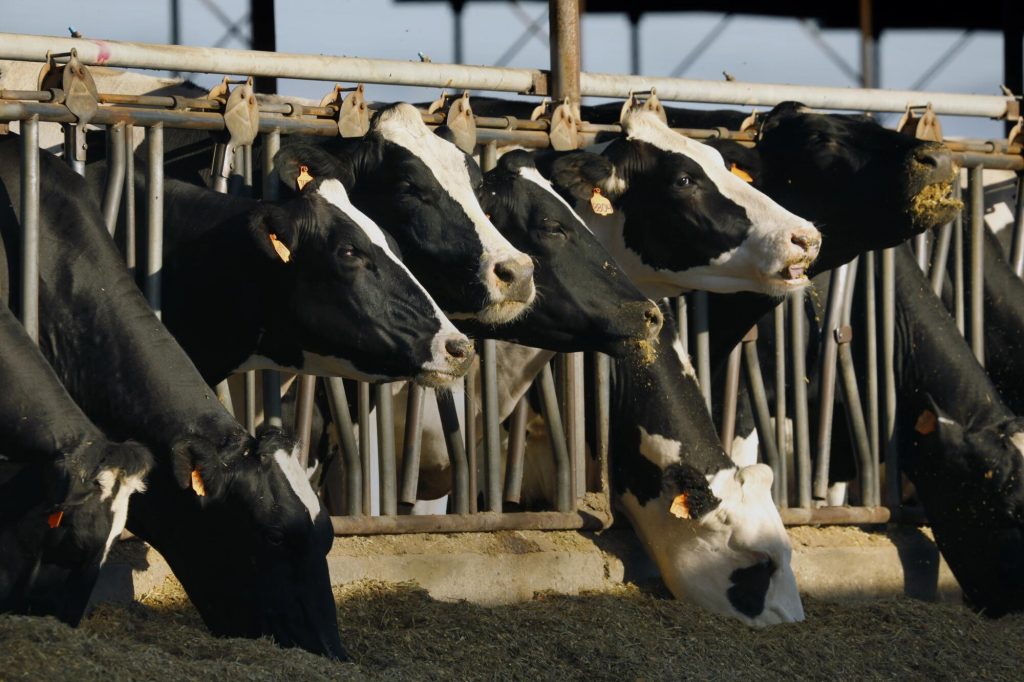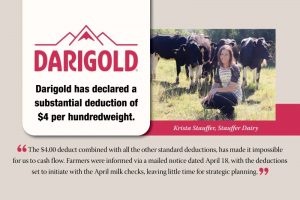
The following is from Lee Mielke, author of a dairy market column known as “Mielke Market Weekly.”
The Agriculture Department announced the August federal order Class III milk price at $20.66 per hundredweight, up 87 cents from July, $3.47 above August 2023, and the highest Class III price since November 2022. It put the eight-month average at $17.75, up from $16.98 a year ago and compares to $22.54 in 2022.
Last Friday morning, Class III futures portended a September price at $22.81; October, $23.06; November, $22.63; and December was at $21.79 per hundredweight.
The Class IV price is $21.58, up 27 cents from July, $2.67 above a year ago, and the highest Class IV since December 2022. Its average now stands at $20.49, up from $18.59 a year ago, and compares to $24.83 in 2022.
Adding fuel to the milk price fire, confirmation has been made on three Central Valley California dairies of the Highly Pathogenic Avian Influenza. Milk output was already struggling there, and generally milk output falls 10-25% in dairy cattle. The so-called bird flu has hampered milk output in at least 13 other states, with 17 cases reported in the last 30 days. Meanwhile, the USDA has authorized a field safety trial of a vaccine for bird flu in dairy cattle.
After jumping 17.25 cents the previous week, cash block Cheddar closed the holiday-shortened Labor Day week at $2.27 per pound, up 6 cents on the week, highest since June 9, 2022, and 34.50 cents above a year ago, as traders awaited last Friday afternoon’s July Dairy Products report. The barrels finished at $2.2750, 1.50 cents higher, 44.75 cents above a year ago, and just a half-cent above the blocks. There were seven CME sales of block on the week and five barrel.
Cheese contacts tell Dairy Market News that demand is steady to strong, depending on variety. Some processors have shifted back to barrels due to the bullish trend. Plant downtime, unrelated to the holiday weekend, continued to be reported by some Midwest contacts, but it has not necessarily prompted an influx in milk.
Early in the week, Midwest cheesemakers reported that the holiday-related spot milk at flat class had disappeared and by mid-week prices were starting above $1 above Class III. A number of cheesemakers said they were not even receiving spot milk offers. Cheesemakers continue to suggest that market price upticks have yet to deter customer interest and some say it has actually spurred buyers to make deals to assure coverage.
Class III milk demand is generally strong from cheesemakers in the West, however, with most school institutions back in session by midweek, milk supplies were not abundant, says DMN, and butter price strength was giving incentive to allocate milk fats in that direction.
Manufacturers are running steady production and block capacity is increasing as new facilities come on-line. Domestic cheese demand is steady but is moderate from international buyers.
Butter fell to $3.1475 last Wednesday but closed Friday at $3.1750, a half-cent higher on the week, and 49.50 cents above a year ago, with 22 sales on the week.
Butter churning shifted into high gear this week in the Central region, particularly the Midwest. Plants in the south have generally had more spot cream available throughout the summer than their Upper Midwest counterparts, says DMN, so the uptick in churning has been less dynamic there. Plant managers did not expect the availability of cream to last beyond the weekend. Butter demand is gathering its seasonal strength from both retail and food service customers.
Western manufacturers indicate retail churning is strong to steady, while bulk lines are at a much lighter pace. Butter inventories are “comfortable” for anticipated fourth quarter demand. The holiday weekend brought mixed cream demand with a few facilities enjoying some downtime. This contributed to looser cream supplies for parts of the region. Some believe lower temperatures recently should allow more requests for cream from the West into the Midwest to be accommodated. Butter demand varies from stronger to steady, says DMN.
Grade A nonfat dry milk closed last Friday at $1.3650 per pound, up 3.50 cents on the week, highest since Dec. 8, 2022 and 26.50 cents above a year ago. There were 19 loads finding new homes on the week.
The whey closed last Friday at 58.75 cents per pound, 2.75 cents higher, highest in four weeks, and 28.50 cents above a year ago, with five sales put on the board.
U.S. dairy exports remained strong in July, up 7.8%, according to HighGround Dairy’s Alyssa Badger in the Sept. 9 “Dairy Radio Now” broadcast. She pointed out that, while exports to Mexico in June were down, month to month and year to year, they turned around in July and were up 21% from July 2023. Exports to China were also higher, she said, as well as to Southeast Asia, up 24%.
Cheese exports totaled 88.7 million pounds, up 9.6%, though Cheddar was down 28.9%. Badger noted that, when these cheese purchases were booked, U.S. prices, although competitive, were not at a steep discount to the global market as they were earlier in the year. And, cheese moving across the southern border to Mexico leapt to its second-highest level ever.
Nonfat/skim milk powder exports hit 159.4 million pounds, up 10.8% from July 2023, and surely helped put CME prices where they are. HighGround Dairy says July’s sailings were the highest since May 2023, with increased shipments to Southeast Asia and Mexico. Demand from China remained lackluster, down 21%, and the smaller exports are keeping year-to-date totals behind, down 8.5%.
Whey exports remained strong, totaling 29.6 million pounds, up 15%, though YTD are down 2%. China was the top destination, according to GHD.
Butter exports amounted to 6 million pounds, increasing for the second month in a row, up 16.3% from a year ago but down 8.6% YTD. Badger said U.S. prices are not at a huge premium to Oceania, and European prices are also higher than ours, so that has helped U.S. exports. We were still a net importer however. Butter imports totaled 13.9 million pounds, up 44.8%, while cheese imports totaled 36.1 million pounds, up 9.8% from a year ago.
Last Tuesday’s Global Dairy Trade auction saw its weighted average slip .4%, following a 5.5% jump on Aug. 20. Volume jumped to 84.5 million pounds, up from 77 million. The average metric ton price slipped to $3,833, down from $3,920.
The declines were led by lactose, down 8.9%, followed by whole milk powder, which was down 2.5% after gaining 7.2% on Aug. 20. Skim milk powder was up 4.5%, after a 4% gain. Butter was off .9%, after rising 3.7%, while anhydrous milkfat was up .7% after jumping 4.8% last time.
Buttermilk powder was up 8.4% and GDT Cheddar was up .9%, after slipping .2% on Aug. 20. Mozzarella was up 7%.
StoneX says the GDT 80% butterfat butter price equates to $2.9538 per pound U.S., down 1.4 cents from Aug. 20, and compares to CME butter which closed last Friday at $3.1750. GDT Cheddar, at $1.9615, was up 2.3 cents, and compares to last Friday’s CME block Cheddar at $2.27. GDT skim milk powder averaged $1.2486 per pound, up from $1.1955, and whole milk powder averaged $1.5404 per pound, down from $1.5794. CME Grade A nonfat dry milk closed last Friday at $1.3650 per pound.
Analyst Dustin Winston said, “North Asia market share, which includes China, stayed even with the last event and increased from last year. We are hearing anecdotal reports that physical distributors were caught short on SMP and WMP leading to this resurgence in demand. With domestic prices in China being so competitive, it is likely this is a momentary interest for the region. The Middle East was weak in this event.”
In other trade news, the U.S. and Chile approved an agreement that further enhances the existing U.S.-Chile Free Trade Agreement. A press release from the International Dairy Foods Assn. stated the agreement will “formalize protections for U.S. cheese exports to Chile, which make up over half of all U.S. dairy exports to Chile and exceeded $55 million in 2023.”
“Chile, which makes up well over half of U.S. cheese exports for the continent, is by far the largest U.S. cheese market in South America.”
“Chile recently concluded negotiations for a free trade agreement with the European Union which sought protections for its geographical indications, including popular U.S. cheese exports to Chile such as parmesan, gruyere and feta,” the IDFA stated. “At the urging of IDFA and fellow industry representatives, the Biden administration engaged in negotiations on an exchange of letters to attach to the existing U.S.-Chile free trade agreement that would further protect some U.S. cheeses from losing access once the EU’s GI commitments enter.”
You can now read the most important #news on #eDairyNews #Whatsapp channels!!!
🇺🇸 eDairy News INGLÊS: https://whatsapp.com/channel/0029VaKsjzGDTkJyIN6hcP1K

























